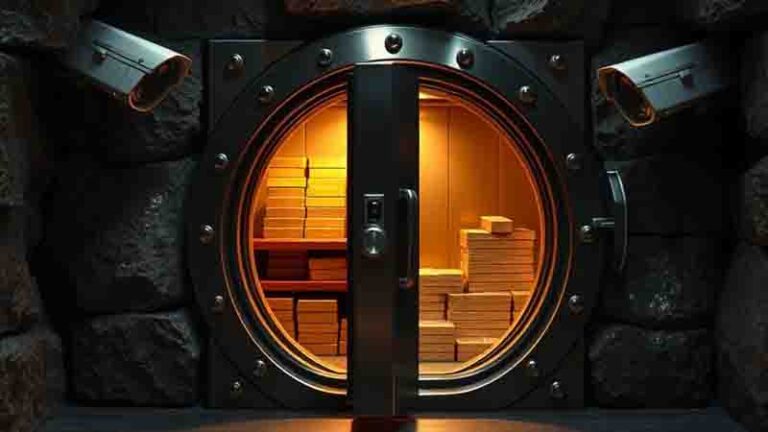How to Secure Your Wealth With Precious Metals
Note: This post may contain affiliate links, and we may earn a commission (with No additional cost for you) if you purchase via our link. See our disclosure for more info. The gold and crypto world is constantly changing. This is not financial, investment, legal, or professional advice. So, please verify the information on the gold and cryptocurrency provider’s websites.
Click below and listen to the podcast on this page.
When you're looking to secure your wealth, precious metals can be a powerful tool in your financial arsenal. You've likely heard about gold and silver as investment options, but there's more to reflect upon than just buying a few coins or bars. Investing in precious metals is complex. It involves, for example, knowing each metal's unique properties. It also requires managing storage and security concerns. Do you want to see how these assets can protect your wealth from economic uncertainties and inflation? You should know the key strategies of seasoned investors. They use them to maximize returns and minimize risks.
Key Takeaways
- Diversify your investment portfolio with 5-10% allocated to precious metals for stability and risk reduction.
- Choose secure storage solutions like home safes, bank deposit boxes, or specialized storage facilities.
- Implement robust security measures including alarm systems, surveillance cameras, and regular security audits.
- Insure your precious metal holdings with tailored coverage that aligns with current market values.
- Stay informed about market trends and global events to navigate volatility effectively.
Understanding Precious Metals as Assets
For centuries, precious metals have been revered as valuable assets, and today they continue to play an essential role in wealth preservation. These metals, including gold, silver, platinum, and palladium, offer intrinsic value and historical significance as stores of wealth. Their scarcity and high value make them attractive additions to any investment portfolio.
Understanding the value of precious metals is vital for investors:
- Gold acts as a safe haven during economic uncertainty, often rising when fiat currencies decline.
- Silver offers both decorative and industrial value, with significant price increases in recent years.
- Precious metals serve as effective hedges against inflation, preserving purchasing power.
- They maintain value during economic downturns, as demonstrated during the 2008 financial crisis.
To safeguard your wealth with precious metals, consider allocating 5%-10% of your portfolio to these assets. This strategy can enhance overall stability, as precious metals tend to move independently of traditional assets like stocks and bonds.
When investing in precious metals, guarantee secure storage to protect your assets from theft or damage. Remember that while precious metals can provide stability, they're still subject to market volatility, so diversification remains key.
Diversifying Your Investment Portfolio
When diversifying your investment portfolio, you'll need to strike a balance between risk and potential reward.
Strategic asset allocation involves distributing your investments across different asset classes, including precious metals, to optimize returns while managing risk.
Balancing Risk and Reward
Balancing risk and reward in your investment portfolio is essential for long-term financial success. Investing in precious metals can help you achieve this balance by reducing your overall risk exposure.
When you add physical bullion to your portfolio, you're introducing an asset class that often moves independently from stocks and bonds. This diversification can protect your wealth during market downturns and economic uncertainties.
Consider allocating 5%-10% of your portfolio to precious metals like gold, silver, and platinum. This strategy can:
- Reduce correlation with traditional assets
- Provide a hedge against market volatility
- Mitigate inflation risks
During financial crises, precious metals have historically retained or increased in value. For example, gold prices surged markedly during the 2008 financial meltdown.
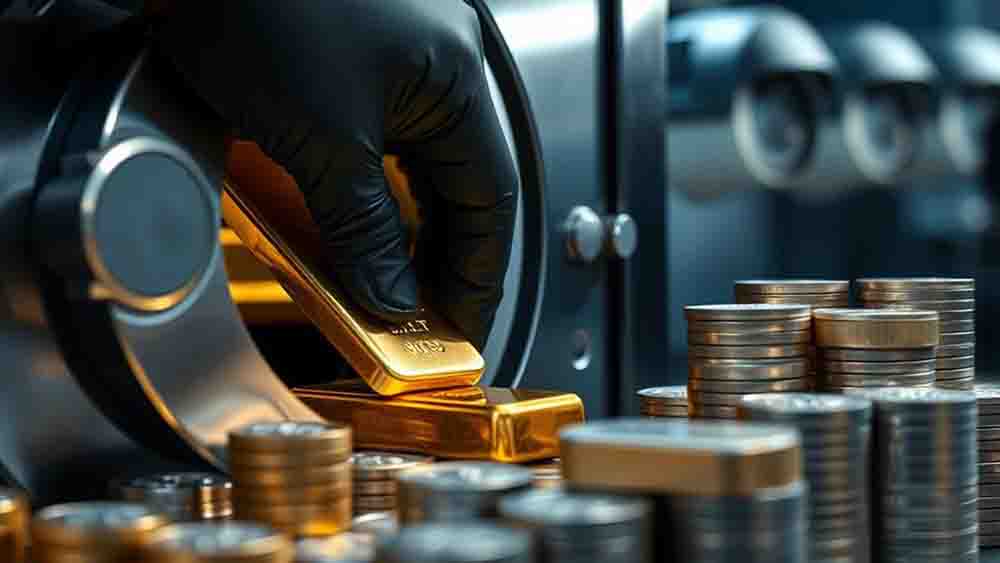
Strategic Asset Allocation
Strategic asset allocation forms the backbone of a well-diversified investment portfolio. When it comes to securing your wealth, incorporating precious metals into your investment strategy can provide stability and protection against economic downturns. By allocating 5%-10% of your portfolio to metals like gold, silver, and platinum, you'll create a buffer against market volatility and inflation.
Consider the following allocation strategy:
| Asset Class | Percentage | Purpose |
|---|---|---|
| Stocks | 60-70% | Growth |
| Bonds | 20-30% | Income |
| Precious Metals | 5-10% | Stability |
The value of gold and other precious metals often rises when traditional investments falter. During the 2008 financial crisis, gold prices surged, demonstrating its ability to retain value in turbulent times. To maximize the benefits of this diversification:
- Mix different metals in your portfolio
- Monitor global economic trends regularly
- Adjust your allocation as needed
Choosing the Right Storage Solutions
Security is paramount when it comes to storing your precious metals. When choosing the right storage solutions for your valuable assets, you'll find several options to suit your needs.
Home safes offer a convenient and accessible choice, with fireproof and waterproof models available to protect against environmental damage. For added security, consider bolted safes that are secured to floors or walls, making them difficult to remove.
Hidden safes, designed to resemble everyday objects, provide an extra layer of protection by concealing your valuables from potential thieves.
If you prefer off-site storage, safe deposit boxes at banks offer high-security storage with climate control features. These boxes are ideal for smaller quantities of precious metals and important documents.
For larger collections or higher-value items, specialized storage facilities like private vaults provide advanced security measures and controlled access.
When selecting a storage solution, consider factors such as:
- Accessibility
- Insurance coverage
- Security features
- Cost
- Size of your collection
Implementing Robust Security Measures
Once you've chosen the right storage solution for your precious metals, it's time to bolster your defenses with robust security measures.
Installing alarm systems is an essential first step, as they can greatly deter theft by alerting you to unauthorized access. Complement this with surveillance cameras in storage areas, which not only monitor activities but also provide critical evidence if needed.
Consider implementing smart locks for controlled access to your physical precious metals, allowing you to track who enters and exits the storage area. This increased accountability enhances your overall security strategy.
Don't overlook the importance of regular security audits to identify vulnerabilities and make timely improvements to your protective measures.
For those storing precious metals at home or in safety deposit boxes, engaging a professional security company for round-the-clock monitoring can offer peace of mind. Their constant vigilance provides an extra layer of protection for your valuable assets.
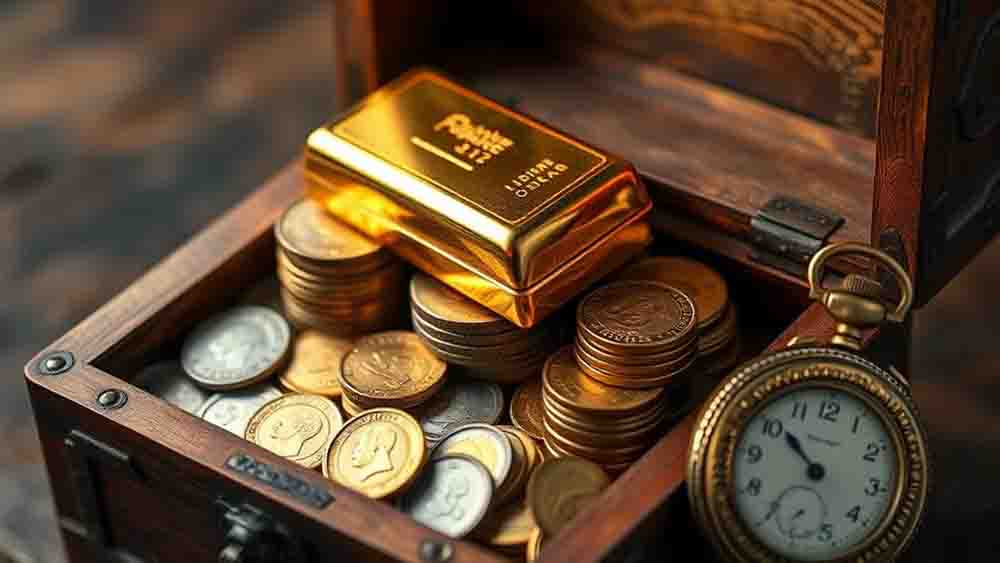
Insuring Your Precious Metal Holdings
When insuring your precious metal holdings, you'll need to explore various coverage options tailored to your specific needs.
Consider key policy selection criteria, such as the type of metals you own, their value, and where they're stored, to guarantee you're adequately protected.
Understanding the claims process is essential, as it'll help you navigate potential losses efficiently and maximize your insurance benefits.
Coverage Options
Insurance plays an essential role in safeguarding your precious metal investments. As an investor, you should consider extensive coverage options designed specifically for precious metals. These policies protect against loss, theft, or damage, ensuring financial security by providing compensation for replacement or repairs.
When selecting coverage, it's vital to choose a plan that reflects the current market value of your holdings. For businesses dealing in precious metals, insurance may be legally required for compliance and risk management. Even if not mandated, it's a wise decision to protect your assets.
Consider these coverage options:
- Extensive policies for general precious metal holdings
- Specialized coverage for rare coins and bullion
- Business-specific insurance for dealers and traders
Regularly review and update your insurance to maintain adequate protection as your collection grows or market values fluctuate. By investing in appropriate coverage, you'll gain peace of mind knowing your precious metals are secured against unforeseen events.
Policy Selection Criteria
Selecting the right insurance policy for your precious metal holdings requires careful evaluation of several key factors. When assessing insurance policies for your precious metals, prioritize thorough coverage that protects against loss, theft, and damage. This guarantees you'll receive financial compensation if something happens to your investments.
Key criteria to take into account when choosing a policy:
- Tailored coverage: Opt for policies specifically designed for rare coins and bullion, as standard coverage may not adequately reflect their true value.
- Adequate protection: Confirm the policy provides sufficient coverage based on the current market value of your precious metals.
- Compliance: If you're a business dealing with precious metals, verify that the policy meets legal requirements for insurance.
- Flexibility: Choose a policy that allows for regular updates to keep pace with fluctuating market values.
- Peace of mind: Select an insurer with a solid reputation for claims handling and customer service.
Remember to review and update your policy regularly to maintain adequate coverage as your collection grows or market values change.
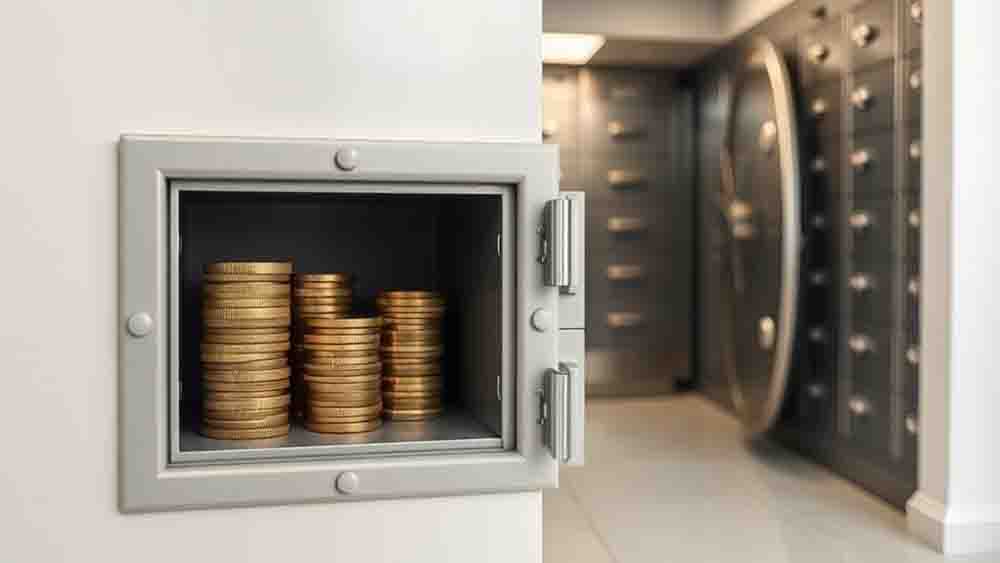
Claims Process Overview
In the event of a loss, theft, or damage to your precious metal holdings, understanding the claims process is vital for a swift and successful resolution.
Insurance providers typically require specific documentation and steps to be followed when filing a claim. To guarantee a smooth process, keep detailed records of your precious metals, including purchase receipts, appraisals, and photographs.
When initiating a claim:
- Contact your insurance provider immediately
- Provide a detailed description of the incident
- Submit all relevant documentation
Most extensive policies covering precious metals require that they be stored in secure locations, such as home safes or specialized storage facilities. This requirement is essential for claim eligibility.
Tailored insurance policies for rare coins and bullion often have specific procedures for valuation and replacement.
To expedite the claims process:
- Maintain an up-to-date inventory of your holdings
- Regularly review and update your policy coverage
- Familiarize yourself with your policy's terms and conditions
Navigating Market Volatility
Market volatility can wreak havoc on traditional investment portfolios, but precious metals offer a beacon of stability during turbulent times. Gold and silver have historically retained or appreciated in value during economic downturns, as evidenced by the 2008 financial crisis when gold prices soared.
Recent market trends further demonstrate this pattern, with gold reaching a record high of $2,265 per ounce in March 2023.
To navigate market volatility effectively, consider these strategies:
- Allocate 5%-10% of your portfolio to precious metals
- Monitor global economic trends and inflation rates
- Stay informed about geopolitical events affecting markets
Precious metals can serve as a hedge against market instability. In 2022, while traditional assets faced losses, gold rose by 0.4%, silver increased by 6.3%, and platinum gained 12.2%.
This performance highlights their potential to enhance portfolio stability and provide a buffer against fluctuations in stock and bond markets.
Long-Term Wealth Preservation Strategies
Throughout the course of history, precious metals have proven to be a reliable cornerstone for long-term wealth preservation. Gold, silver, and other precious metals consistently hold their value over time, making them an essential component of a diversified investment strategy. To secure your wealth for the future, consider allocating 5%-10% of your portfolio to precious metals.
Investing in precious metals offers several advantages:
- Inflation hedge: Gold and silver prices tend to rise during economic instability, protecting your purchasing power.
- Portfolio stability: Precious metals reduce correlation with traditional assets, enhancing overall stability.
- Wealth preservation: Physical ownership of bullion or coins provides direct control over your assets.
To maximize the benefits of precious metals for long-term wealth preservation:
- Diversify across different metals (gold, silver, platinum) to spread risk.
- Consider both physical ownership and secure storage options.
- Monitor market trends and adjust your allocation as needed.
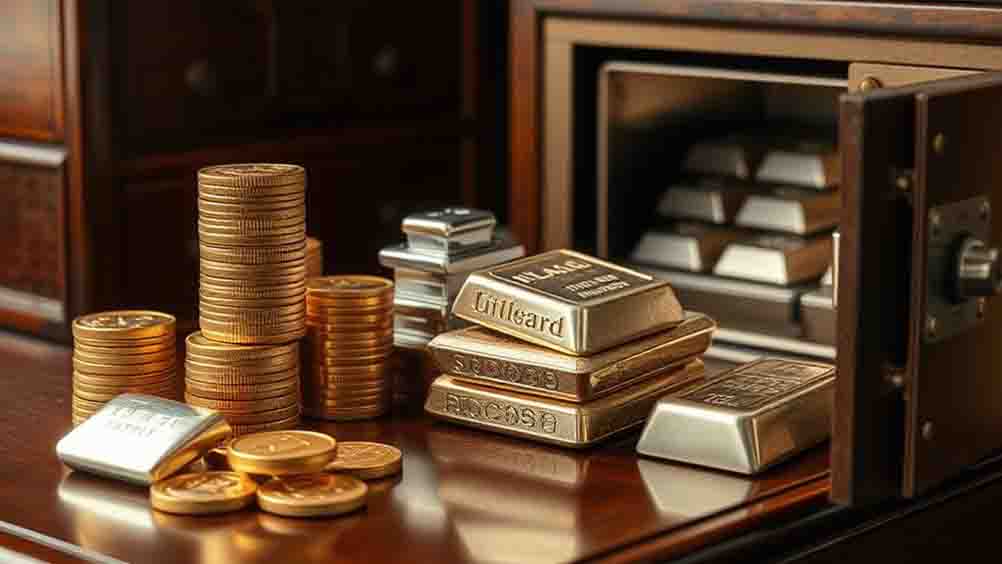
Frequently Asked Questions
How to Make Money With Precious Metals?
To make money with precious metals, you can:
- Invest in physical gold or silver, which can appreciate during economic downturns.
- Trade precious metal ETFs or mutual funds for easier exposure without storage concerns.
- Buy mining stocks for potential capital gains, though this comes with company-specific risks.
- Allocate 5%-10% of your portfolio to precious metals for diversification.
- Stay informed about global economic trends to identify ideal buying and selling opportunities.
How Much of My Wealth Should Be in Precious Metals?
When deciding how much of your wealth to invest in precious metals, consider the general recommendation of 5% to 10% of your total investment portfolio. This allocation can provide stability and diversification.
However, your specific situation matters. Assess your:
- Financial goals
- Risk tolerance
- Overall investment strategy
Remember, precious metals can serve as a hedge against inflation and economic downturns. They're also highly liquid.
Ultimately, you should consult with a financial advisor to determine the most appropriate percentage for your unique circumstances.
What Is the Safest Precious Metal to Invest In?
Gold is generally considered the safest precious metal to invest in.
You'll find it offers unparalleled stability and universal recognition as a store of value. Its liquidity is unmatched, with about $130.9 billion traded daily, making it easy to buy and sell.
While silver, platinum, and palladium have their merits, gold's historical performance and widespread acceptance give it an edge.
However, remember that diversifying across multiple precious metals can enhance your portfolio's overall resilience and safety.
Which Metal Is Good for Wealth?
When considering which metal is good for wealth, you've got several options to choose from.
Gold remains a classic choice, offering stability during economic uncertainties.
Silver's industrial applications make it a versatile investment.
Platinum's rarity and use in various sectors provide diversification potential.
Palladium's growing importance in technology makes it an intriguing option.
To maximize your wealth protection, you might consider investing in a mix of these metals, as each offers unique benefits and can help balance your portfolio.
Conclusion
As you've learned, securing your wealth with precious metals takes careful planning and execution. Diversify your portfolio. Choose proper storage. Implement security measures. Get insurance. This will protect your assets from economic risks. Remember to regularly monitor market trends and adjust your strategy accordingly. These steps will help you protect your wealth and buying power, long-term. Precious metals can be a valuable component of your financial security plan when managed wisely.








